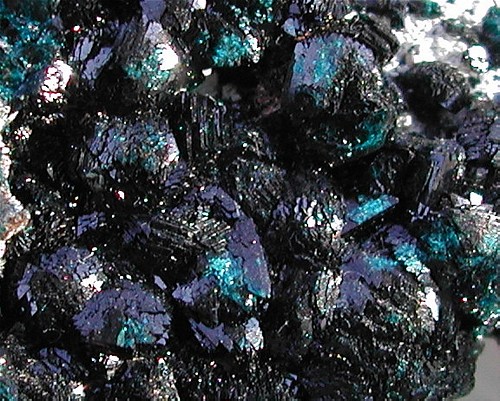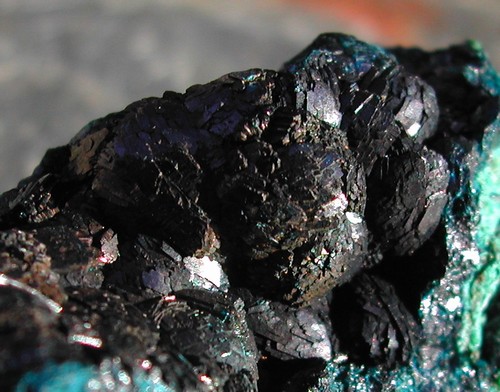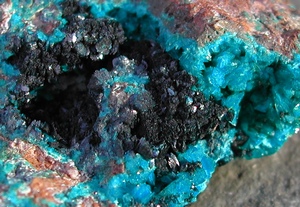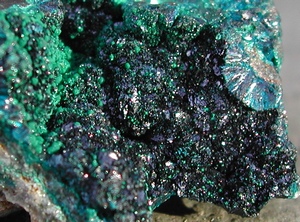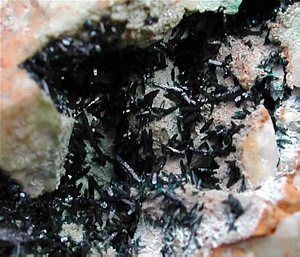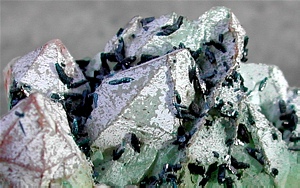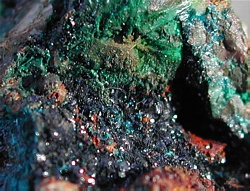|
|
 |
 |
 |
|
 |
 |
 |
|
 |
|
|
|
Clinoclase in another very rare secondary copper arsenate found in the oxidation zone of copper deposits, and is sometimes found associated with Liroconite.
It has only been found in a few sites in the world, some of the most well known being Wheal Gorland, Gwennap, Cornwall in the UK, its type locality, and Majuba Hill, Pershing County,
Nevada, USA. Both have yielded some wonderful Clinoclase display specimens. Both these mines are now closed, and good well crystallised specimens are only rarely available and command a high price.
|
|
|
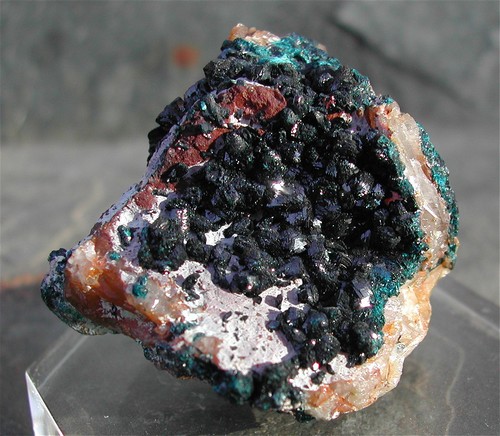 |
|
|
|
Clinoclase - Wheal Unity, Gwennap, Cornwall, UK
Dark blue-black lustrous crystalline 4mm aggregates of Clinoclase, known as "beetle ore".
|
|
 |
 |
|
Clinoclase Discovery
Clinoclase was first found in the old copper mines of Cornwall, at the same time as Liroconite with which it was often associated.
The main source of Clinoclase were the Wheal Gorland, Wheal Unity and Wheal Muttrell mines in the Gwennap area near St Day. It was first given the name Clinoclase by Breithaupt in 1830, the name coming from the Greek Klineis "to incline" and Klas "to break" after its oblique cleavage. The name expresses the fact that the basal cleavage is inclined to the faces of the oblique prism. Variations of this name include Clinoclasita, Clinoclasit, Clinoclasite, Klinoklas and Klinoclas. It has also been given a number of other names: Oblique Prismatic Arseniate of Copper, Abichit (and Abichita, Abichite, Aphanese, Aphanesit, Aphanesite, Aphanesita), Siderochalcit (and Siderochalcita, Siderochalcite), and Strahlenkupfer.
|
|
|
 |
 |
|
Clinoclase Habit & Form
Clinoclase is very distinctive and has a totally different colour and crystal shape to Liroconite. The Cornish arsenates of copper were studied in the early 1800's by
the Comte de Bournon, who was led to remark that "Nature has established very remarkable differences between the arseniates of copper."
While the chemistry of the copper arsenates such as Liroconite, Clinoclase, Olivenite, Cornwallite and Chalcopyllite, is fairly similar, their external appearance is radically different. This can lead to some very beautiful mineral specimens, with the various copper arsenates contrasting with each other in form and colour.
|
|
 |
 |
|
Clinoclase - Wheal Unity, Gwennap, Cornwall, UK
Long acicular Clinoclase crystals to 4mm on Quartz. Collected in 1977 by Richard Barstow. Same specimen as above.
|
 |
 |
|
Clinoclase Chemical Characteristics
|
 |
|
|
|
Chemical formula
|
Cu3AsO4(OH)3
|
|
Chemistry
|
Copper Arsenate Hydroxide
|
|
Class
|
Phosphates
|
|
Subclass
|
Arsenates
|
|
Dana class
|
41.3.1.1
|
|
Strunz class
|
7/B.13-20
|
|
Composition:
|
Copper 50.09%
|
|
|
Arsenic 19.69%
|
|
|
Hydrogen 0.79%
|
|
|
Oxygen 29.43%
|
|
Chemical indicator
|
Slightly soluble in hydrochloric acid
|
|
|
|
|
 |
|
|
|
Colour
|
Very dark blue-black, Blackish blue-green, Dark greenish black
|
|
Streak
|
Bluish green
|
|
Lustre
|
Vitreous - pearly
|
|
Luminescence
|
None
|
|
Transparency
|
Translucent
|
|
Optical Data
|
Biaxial (-), a=1.73, b=1.87, g=1.91, bire=0.1800, 2V(Calc)=52, 2V(Meas)=30. Dispersion relatively strong.
|
|
Hardness
|
2.5 - 3
|
|
Specific Gravity
|
4.19 to 4.40, average 4.29
|
|
Crystal System
|
Monoclinic, 2/m
|
|
Axial Ratios
|
a:b:c = 1.917 : 1 : 1.124
|
|
Cell Dimensions
|
a = 12.4, b = 6.47, c = 7.27, Beta=99.58°
|
|
X-Ray Diffraction
|
by Intensity(I/Io): 3.587(1), 3.139(0.25), 7.21(0.2)
|
|
Cleavage
|
Good in one direction
|
|
Fracture
|
Lamellar. Flat surfaces fracture in an uneven pattern.
|
|
Associated Minerals
|
Liroconite, Cornwallite, Olivenite, Chalcopyllite, Malachite, Azurite, Cuprite, Adamite, Brochantite
|
|
Best Field Indicators
|
Colour, streak, crystal habit, associated minerals, and density
|
|
 |
 |
|
Copyright (C) 2003-2008 David Aubrey-Jones. All rights reserved. No part of this Web site and its contents may be reproduced in any form without the written permission of the author.
|
|


